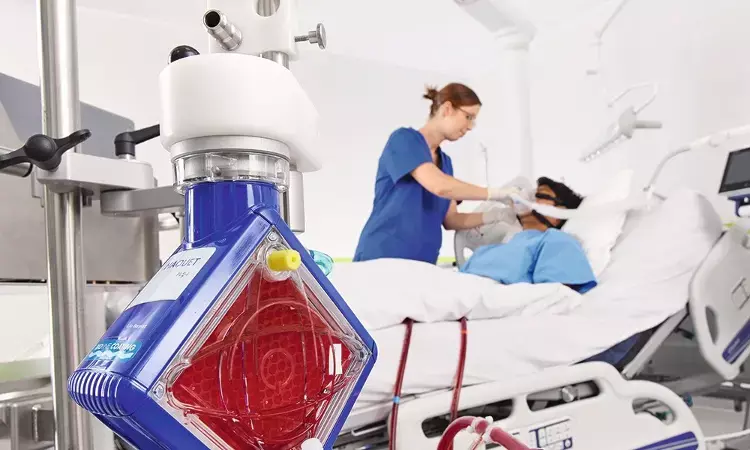- Home
- Medical news & Guidelines
- Anesthesiology
- Cardiology and CTVS
- Critical Care
- Dentistry
- Dermatology
- Diabetes and Endocrinology
- ENT
- Gastroenterology
- Medicine
- Nephrology
- Neurology
- Obstretics-Gynaecology
- Oncology
- Ophthalmology
- Orthopaedics
- Pediatrics-Neonatology
- Psychiatry
- Pulmonology
- Radiology
- Surgery
- Urology
- Laboratory Medicine
- Diet
- Nursing
- Paramedical
- Physiotherapy
- Health news
- Fact Check
- Bone Health Fact Check
- Brain Health Fact Check
- Cancer Related Fact Check
- Child Care Fact Check
- Dental and oral health fact check
- Diabetes and metabolic health fact check
- Diet and Nutrition Fact Check
- Eye and ENT Care Fact Check
- Fitness fact check
- Gut health fact check
- Heart health fact check
- Kidney health fact check
- Medical education fact check
- Men's health fact check
- Respiratory fact check
- Skin and hair care fact check
- Vaccine and Immunization fact check
- Women's health fact check
- AYUSH
- State News
- Andaman and Nicobar Islands
- Andhra Pradesh
- Arunachal Pradesh
- Assam
- Bihar
- Chandigarh
- Chattisgarh
- Dadra and Nagar Haveli
- Daman and Diu
- Delhi
- Goa
- Gujarat
- Haryana
- Himachal Pradesh
- Jammu & Kashmir
- Jharkhand
- Karnataka
- Kerala
- Ladakh
- Lakshadweep
- Madhya Pradesh
- Maharashtra
- Manipur
- Meghalaya
- Mizoram
- Nagaland
- Odisha
- Puducherry
- Punjab
- Rajasthan
- Sikkim
- Tamil Nadu
- Telangana
- Tripura
- Uttar Pradesh
- Uttrakhand
- West Bengal
- Medical Education
- Industry
Extracorporeal Carbon Dioxide Removal in Critically ill Adults: Meta-analysis

Recently published study discussed in the research paper is a systematic review and meta-analysis focusing on the impact of extracorporeal carbon dioxide removal (ECCO2R) on gas exchange and respiratory settings in critically ill adults with respiratory failure. The review included a comprehensive database search for observational studies and randomized controlled trials (RCTs) targeting adult ICU patients undergoing ECCO2R. The primary outcomes assessed included changes in gas exchange and ventilator settings 24 hours after ECCO2R initiation, mortality, length of stay, ventilation days, and adverse events. A total of 49 studies encompassing 1672 patients were included in the analysis, with key findings indicating a significant decrease in PaCO2, plateau pressure, and tidal volume, as well as an increase in pH across all patient groups, with an overall 19% adverse event rate. In ARDS and lung transplant patients, the PaO2/FiO2 ratio increased significantly while ventilator settings were variable, and "higher extraction" systems were found to reduce PaCO2 and respiratory rate more efficiently. However, the available RCTs did not demonstrate a mortality benefit but did show a significantly longer ICU and hospital stay associated with ECCO2R. The review concluded that ECCO2R effectively reduces PaCO2 and acidosis, allowing for less invasive ventilation, and "higher extraction" systems may be more efficient to achieve this goal. However, as RCTs have not shown a mortality benefit but have shown an increase in adverse events, ECCO2R's effects on clinical outcome remain unclear. The study emphasizes the need for future studies targeting patient groups that may benefit from ECCO2R and highlights potential limitations and risks associated with ECCO2R, especially in the context of adverse events.
Key Points
1. The analysis included 49 studies with 1672 patients and found that ECCO2R led to a significant decrease in PaCO2, plateau pressure, and tidal volume, as well as an increase in pH. In specific patient groups like ARDS and lung transplant patients, the PaO2/FiO2 ratio increased significantly with variable effects on ventilator settings, and "higher extraction" systems were found to reduce PaCO2 and respiratory rate more efficiently. However, the available RCTs did not demonstrate a mortality benefit, and there was a 19% adverse event rate associated with ECCO2R.
2. The review concluded that ECCO2R effectively reduces PaCO2 and acidosis, allowing for less invasive ventilation, and "higher extraction" systems may be more efficient. However, the overall effects on clinical outcomes remain unclear, and there is a need for future studies targeting patient groups that may benefit from ECCO2R while considering potential limitations and risks associated with adverse events.
Reference -
Stommel, AM., Herkner, H., Kienbacher, C.L. et al. Effects of extracorporeal CO2 removal on gas exchange and ventilator settings: a systematic review and meta-analysis. Crit Care 28, 146 (2024). https://doi.org/10.1186/s13054-024-04927-x
MBBS, MD (Anaesthesiology), FNB (Cardiac Anaesthesiology)
Dr Monish Raut is a practicing Cardiac Anesthesiologist. He completed his MBBS at Government Medical College, Nagpur, and pursued his MD in Anesthesiology at BJ Medical College, Pune. Further specializing in Cardiac Anesthesiology, Dr Raut earned his FNB in Cardiac Anesthesiology from Sir Ganga Ram Hospital, Delhi.


